
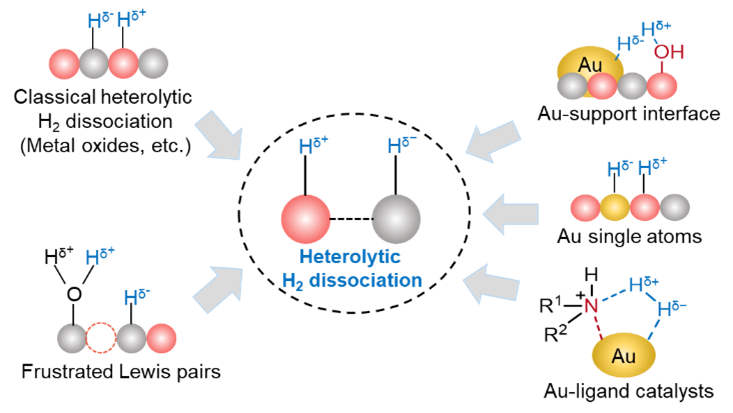
Ping Jin, Nengchao Luo*, Feng Wang*
ACS Catal., 2024, DOI: 10.1021/acscatal.4c05629.
Hydrogenation is an essential type of reaction and dominates reduction reactions in the chemical industry. Metal nanoparticle-based homolytic H2 dissociation enables hydrogenation reactions while less selective for polar functional groups. Heterolytic H2 dissociation originates polar reductive species of Hδ+ and Hδ− pairs, enabling regioselective hydrogenation and moderating hydrogenation extent. In this Perspective, with an initial review of classic homolytic and heterolytic H2 dissociation for comparison, we elucidate the unified mechanism of different forms of heterolytic H2 dissociation on heterogeneous catalysts, aiming to inspire findings on heterolytic H2 dissociation that operates with activity comparable to that of homolytic H2 dissociation on metal nanoparticles.
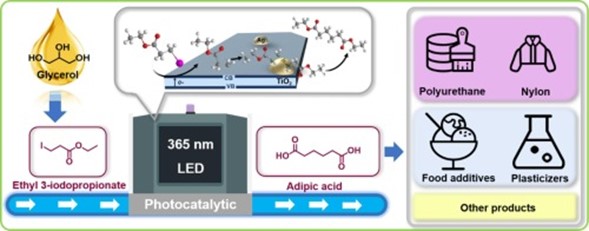
Yang Peng a,b,1, Nengchao Luo c,* a, Weiran Yang a,*
J. Catal., 2024, DOI: 10.1016/j.jcat.2024.115899
The synthesis of adipic acid from sustainable biomass derived substrates under mild conditions is an important research area in green chemistry. Here, an innovative heterogeneous photocatalytic system was reported to prepare diethyl adipate (yield: 85% and apparent quantum efficiency: 12.9%) by dehalogenative C-C homocoupling of glycerol-derived ethyl 3-iodopropionate using Ag/TiO2 as catalyst with base (cesium carbonate) as additive. This work provides an environmentally benign route for adipic acid synthesis from glycerol derivative and a new catalytic strategy for dehalogenative C-C homocoupling of halogenated compounds.

Xuke Chen#, Yu Xia#, Yifan Yang, Yunpeng Xu, Xiuquan Jia*, Richard N. Zare*, Feng Wang*
J. Am. Chem. Soc., 2024, DOI: 10.1021/jacs.4c11224
Electrification of water in clouds leads to fascinating redox reactions on Earth. However, little is known about cloud electrochemistry except for lightning, a natural hazard that is nearly impossible to harness. We report a controllable electrochemistry that can be enabled in microclouds by fast phase switching of water between the microdroplet, vapor, and bulk phase. Due to the size-dependent charge transfer between droplets during atomization, this process generates an alternating voltage through self-electrification and discharge among these phases. The microclouds with alternating voltage cause 1,2-dichloroethane to be converted to vinyl chloride at ~80% selectivity. These findings highlight the importance of controlled cloud electrochemistry in accelerating the removal of volatile organic compounds and treating contaminated water.
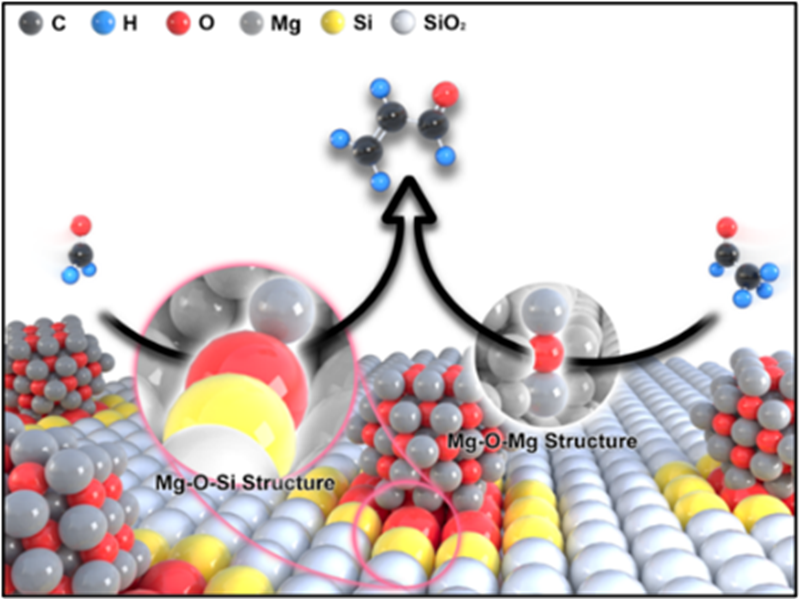
Mingwei Wang+, Zhen Shi+, Zhiquan Yu, Shushuang Li, Zhixin Zhang,* Feng Wang
ChemCatChem,2024,DOI:10.1002/cctc.202400441
Acid-base synergistic catalysis greatly enhances the performance of MgO based catalysts in the Aldol condensation. The results indicated that the weak acidic sites combined with the medium basic sites were beneficial for the cross condensation of HCHO and acetaldehyde. The loading of MgO nanocrystals on SiO2 induced the generation of new acidic sites (Mg-O-Si). Combined with the inherent basic sites (Mg-O-Mg) and Mg-O-Si, the acid-base bifunctions sites could catalyse the cross condensation of HCHO and acetaldehyde synergistically. The appropriate proportion of acidic/basic sites was critical for the cross condensation in the presence of vast water in formalin. The results showed that 10 wt% MgO/SiO2 catalyst exhibited the highest catalytic activity (Conv. Acetaldehyde=57.9%, Sel. Acrolein =84.3% selectivity of acrolein) under the optimal reaction parameters. The catalyst could be recovered after in-situ regeneration in air to remove the carbon deposition.

Yuting Zhu, Ning Li, Huifang Liu, Cheng Cai, Yehong Wang, Junju Mu, and Feng Wang*
ACS Catal., 2024, 14, 16872−16884 (DOI: 10.1021/acscatal.4c04159)
To address the trade-off between the monophenol and cellulose production in the oxidative catalytic fractionation (OCF) of lignocellulose, we develop an enhanced OCF using a CuMnCeO2 solid solution as the catalyst. Under 0.1 MPa O2, 28.7 wt % monophenols were released from birch, using catalytic amounts of Cu (the Cu dosage was about 0.03 mol equiv relative to the aromatic units in lignin). Meanwhile, up to 83.9% of cellulose was collected. Characteristic studies demonstrate the abundant surface oxygen vacancies facilitated oxygen activation by well-dispersed Cu and Mn species, while the strong interaction between these metals enhanced the catalyst’s reducibility. Key intermediates such as β-vinyl aryl ethers and byproduct glycolic acid were identified by model experiments, confirming that lignin oxidation primarily followed a 1,2−dioxetane homolysis mechanism. Overall, this enhanced OCF demonstrates the potential viability of lignin oxidation in practical biorefinery applications.

Siqi Li,# Yuda Zhang,# Yehong Wang* and Feng Wang
J. Phys. Chem. Lett. 2024, 15, 41, 10278–10283
Ethyl acetate is an important chemical, and ethanol dehydrogenative condensation with 95.6% atomic economy is a promising synthetic route. CuZrO-based catalysts are widely applied in this reaction; however, the effect of the ZrO2 crystal phase in the CuCeZrO catalyst upon reaction deserves to be explored further. Herein, the ZrO2 crystal phase was regulated by controlling calcination temperature. Additionally, monoclinic ZrO2 with limited density of the strong base is found to be more beneficial to the selective production of ethyl acetate from ethanol, while tetragonal ZrO2 with abundant strongly basic sites is more inclined to the formation of butanol and its downstream esters. This work not only improves our understanding of the crystal phase effect in a CuCeZrO catalytic system but also paves the way for the development of more efficient catalysts for ethyl acetate production.

Genheng Li,# Juntao Ren,# Zhipeng Huang,* Jianyu Han, Nengchao Luo, Yanming Hu, Feng Wang*
ACS Catal. 2024, 14, 14564−14573 DOI: 10.1021/acscatal.4c03129
Biomass-derived fatty acids are promising candidates for the production of linear α-olefins (LAOs). Under irradiation, they can be facilely transformed into alkyl radicals over heterogeneous photocatalysts. However, the subsequent dehydrogenation of generated radical intermediates to produce valuable LAOs remains kinetically challenging. Here we demonstrate that CO decoration on Pd nanoparticles can promote LAO production from fatty acids by significantly lowering the energy barrier for alkyl radical intermediate dehydrogenation. 1-Undecene can be obtained from lauric acid in a yield of 46% over a Pd/TiO2 photocatalyst. Polymerization of the synthesized 1-undecene and subsequent mechanical tests clarify its potential to be used as a renewable comonomer. Our research puts forward an efficient protocol to control the conversion of radical intermediates over heterogeneous catalytic sites for biomass upgrading.
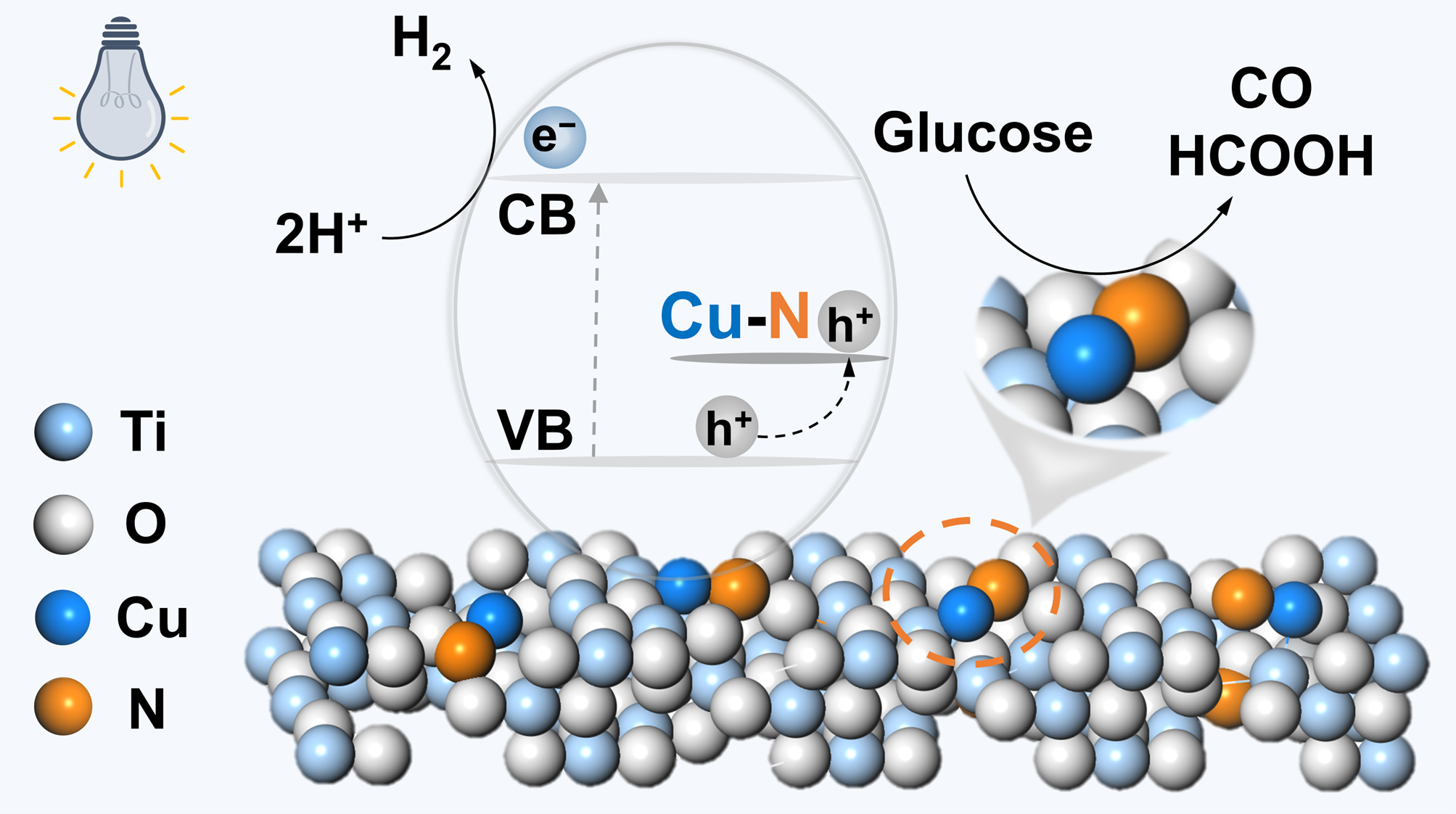
Lulu Sun#, Shiyang Liu#, Taifeng Liu*, Dongqiang Lei, Nengchao Luo*, Feng Wang
Chin. J. Catal., 2024, 63, 234-243, DOI:10.1016/S1872-2067(24)60098-7
Photocatalytic decomposition of sugars is a promising way of providing H2, CO, and HCOOH as sustainable energy vectors. However, the production of C1 chemicals requires the cleavage of robust C−C bonds in sugars with concurrent production of H2, which remains challenging. Here, the photocatalytic activity for glucose decomposition to HCOOH, CO (C1 chemicals), and H2 on Cu/TiO2 was enhanced by nitrogen doping. Owing to nitrogen doping, atomically dispersed and stable Cu sites resistant to light irradiation are formed on Cu/TiO2. The electronic interaction between Cu and nitrogen ions originates valence band structure and defect levels composed of N 2p orbit, distinct from undoped Cu/TiO2. Therefore, the lifetime of charge carriers is prolonged, resulting in the production of C1 chemicals and H2 with productivities 1.7 and 2.1 folds that of Cu/TiO2. This work provides a strategy to design coordinatively stable Cu ions for photocatalytic biomass conversion.
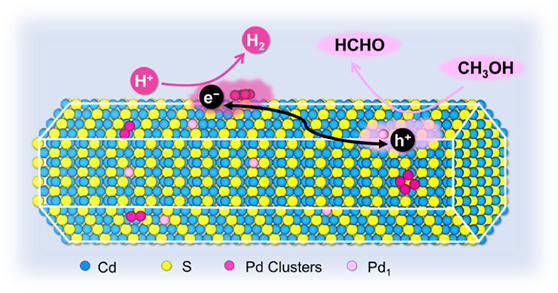
Zhuyan Gao#, Tiziano Montini#, Junju Mu, Nengchao Luo*, Emiliano Fonda, Paolo Fornasiero*, and Feng Wang*
J. Am. Chem, Soc. 2024, DOI: 10.1021/jacs.4c06573
Supported metal in the form of single atoms, clusters, and particles can individually or jointly affect the activity of supported heterogeneous catalysts. While the individual contribution of the supported metal to the overall activity of supported photocatalysts has been identified, the joint activity of mixed metal species is overlooked because of their different photoelectric properties. Here, atomically dispersed Pd and Pd clusters are loaded onto CdS, serving as oxidation and reduction sites for methanol dehydrogenation. The Pd1 substitutes Cd2+, forming hole-trapping states for methanol oxidation and assisting the dispersion of photodeposited Pd clusters. Therefore, methanol dehydrogenation on CdS with supported Pd1 and Pd clusters exhibits the highest turnover frequency of 1.14 s–1 and affords H2 and HCHO with a similar apparent quantum yield of 87 ± 1% at 452 nm under optimized reaction conditions.

Kun Zhang, Junju Mu, Qiang Guo*, Yehong Wang, Yinpan Zhang, Jian Zhang, and Feng Wang*
ACS Catal. 2024, 14, XXX, 11302–11307, DOI: 10.1021/acscatal.4c01427
During the Prins condensation of formaldehyde with propene, the reaction involving the 1-butanol-3-carbocation determines the final products. Due to the hyperconjungation effect, 1-butanol-3-carbocation is highly reactive and easily deprotonates to form 3-buten-1-ol and its derivatives, and this significantly limits its electrophilic addition with formaldehyde to generate 4-methyl-1,3-dioxane. Herein, we demonstrate a distinctive solvent effect on the pathway of Prins condensation of formaldehyde with propene on solid acid catalysts: Hydrogen bonding with water stabilizes 1-butanol-3-carbocation and weakens the hyperconjugation effect, which promotes electrophilic addition of 1-butanol-3-carbocation with formaldehyde to produce 4-methyl-1,3-dioxane. Selectivity of 4-methyl-1,3-dioxane was increased from 34.6% to 78.9% and 4-methyl-1,3-dioxane yield can be boosted up to 7.6-fold over Amberlyst-15 under optimized conditions.

Teera Butburee,* Ampawan Prasert, Bunyarat Rungtaweevoranit, Pongtanawat Khemthong, Poobodin Mano, Saran Youngjan, Jakkapop Phanthasri, Supawadee Namuangruk, Kajornsak Faungnawakij,* Lijuan Zhang, Ping Jin, Huifang Liu, and Feng Wang*
Small, 2024, 2403661.
Efficient conversion of biomass wastes into valuable chemicals has been regarded as a sustainable approach for green and circular economy. Herein, a highly efficient catalytic conversion of glycerol into glycerol carbonate by carbonylation with the commercially available urea is presented using low-cost transition metal single atoms supported on zinc oxide quantum dots (M1-ZnO QDs) as a catalyst without using any solvent. A facile one-step wet chemical synthesis allows various types of metal single atoms to simultaneously dope and introduce Lewis-acid defects in the ZnO QD structure. Doping with a trace amount of isolated metal atoms greatly boosts the catalytic activity. Congruential results from both DFT and in situ DRIFTS studies reveal that the superior catalytic performance can be attributed to the enriched Lewis acid sites that endow optimal adsorption, formation of the intermediate for coupling between urea and Gly, and desorption of GlyC.

Xuke Chen#, Yu Xia#, Yingfeng Wu#, Yunpeng Xu, Xiuquan Jia*, Richard N. Zare*, Feng Wang*
J. Am. Chem. Soc., 2024, DOI: 10.1021/jacs.4c01455
Direct utilization of water as a source of hydrogen atoms and molecules is fundamental to the evolution of the ecosystem and industry. However, liquid water is an unfavorable electron donor for forming these hydrogen species owing to its redox inertness. We report oil-mediated electron extraction from water microdroplets, which is easily achieved by ultrasonically spraying an oil-water emulsion. This involves contact electrification and mutual neutralization at oil-water microdroplet interfaces that facilitated the generation of hydrogen species (•H and H2). The reductive hydrogen species could further lead to an in-situ CO2 hydrogenation process run at normal temperature for selective CO formation. These findings emphasize the potential of charge separation enabled by spraying an emulsion of liquid water and a hydrophobic liquid in driving hydrogenation reactions.

Ning Li, Kexin Yan, Thanya Rukkijakan, Jiefeng Liang, Yuting Liu, Zhipeng Wang, Heran Nie, Suthawan Muangmeesri, Gonzalo Castiella-Ona, Xuejun Pan, Qunfang Zhou, Guibin Jiang, Guangyuan Zhou, John Ralph, Joseph S. M. Samec* & Feng Wang*
Nature, 2024, DOI: 10.1038/s41586-024-07446-5
When chemically treated, lignin is compromised owing to detrimental intra- and intermolecular crosslinking that hampers downstream process. Here we leverage the proclivity by directing the C–C bond formation in a catalytic arylation pathway using lignin-derived phenols with high nucleophilicity. The selectively condensed lignin, isolated in near-quantitative yields while preserving its prominent cleavable β-ether units, can be unlocked in a tandem catalytic process involving aryl migration and transfer hydrogenation. Lignin is converted to benign bisphenols that represent performance-advantaged replacements for their fossil-based counterparts. Delignified pulp from cellulose and xylose from xylan are co-produced for textile fibres and renewable chemicals. This condensation-driven strategy represents a key advancement complementary to other promising monophenol-oriented approaches targeting valuable platform chemicals and materials, thereby contributing to holistic biomass valorization.

Huakai Li, Zhiquan Yu*, Zhixin Zhang, Shushuang Li, Zhen Shi, Changjun Ni, Lei Cao, Hong Du, Qun-Xing Luo*, Feng Wang
Industrial & Engineering Chemistry Research, 2024, DOI: 10.1021/acs.iecr.4c00388
A series of SiO2-supported silicotungstic acid (STA/SiO2) catalysts were prepared by the incipient impregnation method and utilized in dehydration of ethanol to ethylene. The catalysts were characterized through XRD, N2 physical adsorption, TEM, XRF, FTIR, Py-FTIR, Raman spectroscopy, and TG/DSC. The influence of loading amount and calcination temperature on the properties and catalytic activities were investigated. The yield of ethylene was 93.9% at an ethanol conversion of 96.9% over the 36-STA/SiO2(250) catalyst at 240 °C and 1.0 MPa. The kinetics study indicated that diethyl ether was an intermediate under the investigated reaction conditions. A consecutive slow decrease in ethanol conversion and ethylene yield was observed after the 800-h run, which was due to the decreased Brønsted amount caused by carbon deposition, rather than the change of crystal phase or leaching of active sites.

Shiyang Liu, Yike Huang, Nengchao Luo*, Jian Zhang, Botao Qiao, Feng Wang*
ACS Catalysis, 2024, DOI: 10.1021/acscatal.4c01132
Dimethyl ether (DME) coupling via prior C−H bond scission affords H2 and long-chain oxygenates that can be used as diesel fuel additives. However, the C−H bond of DME is recalcitrant, requiring oxidants to activate for subsequent C−C bond coupling, whereas over-oxidation to CO2 by non-selective oxidants is inevitable. Here, by establishing a channel for hole transfer from Pt/TiO2 photocatalyst to DME, the C−H bond of DME is broken, affording H2 and diesel fuel additives consisting of glycol dimethyl ether (GDE) and the oligomers. Adsorbed water on Pt/TiO2 fosters the hole transfer by forming hydrogen bonds with both Pt/TiO2 surface and DME. Because of the hydrogen bonding, photogenerated holes are extracted from Pt/TiO2 by water and eventually transferred to DME. Therefore, the productivities of the diesel fuel and H2 are improved to 8.7 and 12.4 folds. This work provides a route to produce two kinds of fuels from abundant feedstock.

Yinpan Zhang, Qiang Guo*, Feng Wang*
ChemCatChem, 2024, DOI: 10.1002/cctc.202301568
The carbonylation reaction of olefins is one of the significant pathways for the synthesis of oxygen-containing compounds such as aldehydes, esters, and amides. The ethylene carbonylation reactions have drawn much interest since they produce important chemicals such as propionaldehyde and methyl propionate, which are crucial intermediates for the synthesis of polymers. Moreover, ethylene carbonylation, coupled with C-C bond formation, shows great promise for the synthesis of 3-pentanone. However, due to the presence of various competing reactions, balancing the activity and selectivity of ethylene carbonylation reactions has remained a challenge. This concept article aims at describing the recent advances in the ethylene carbonylation with different hydrogen sources.
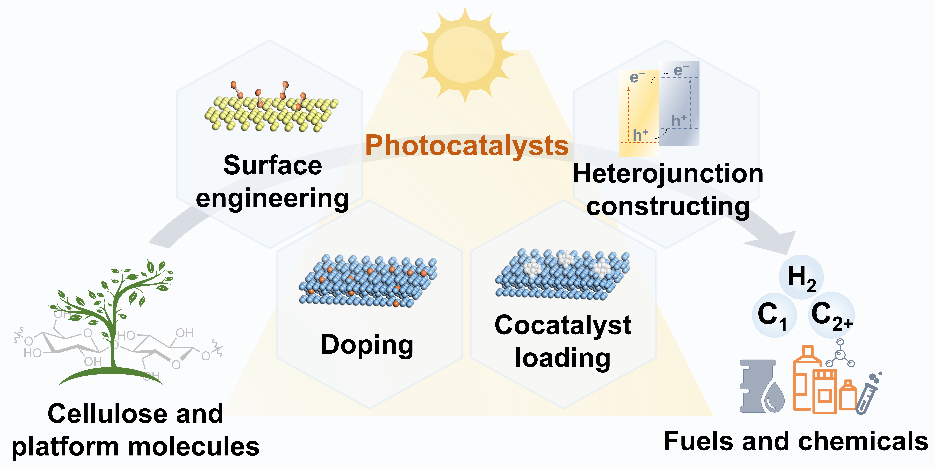
Lulu Sun, Nengchao Luo*
J. Energy Chem., 2024, 94, 102-127, DOI:10.1016/j.jechem.2024.02.053
Lignocellulosic biomass is the largest renewable hydrocarbon resource on earth. Converting cellulose, one of the major components of lignocellulose, powered by solar energy is a promising way of providing low-carbon-footprint energy chemicals such as H2, HCOOH, CO, and transportation fuels. Charge separation in photocatalysts and interfacial charge transfer between photocatalysts and cellulose affect the activity and selectivity of cellulose refineries to H2 and carbonaceous chemicals. This review summarizes photocatalysts for the refineries of cellulose and downstream platform molecules based on the types of products, with the structure features of different types of photocatalysts discussed about the targets of either improving the activity or product selectivity. In addition, this review also sheds light on the methods for designing and regulating photocatalyst structures, meanwhile summarizing proposed future research challenges and opportunities.
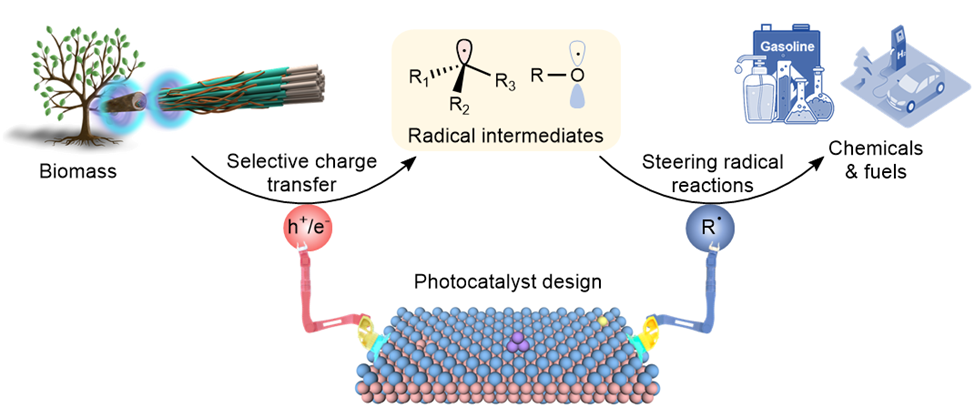
Zhuyan Gao#, Puning Ren#, Lulu Sun, Nengchao Luo*, and Feng Wang*
Nature Synthesis, 2024, DOI: 10.1038/s44160-024-00499-4
Photocatalysis has emerged as a green protocol for biorefineries thanks to sustainable energy input. The unique radical mechanism of photocatalysis allows the decomposition of raw biomass and the precise functionalization of platform molecules, but radicals with open-shell electronic structures are highly active, resulting in diverse products. Control of the radical mechanism relies on photocatalysts guiding interfacial charge transfer for chemical bond breaking. The reaction behaviour of radicals and the surface states of semiconductor photocatalysts are therefore crucial for controlling the efficiency and selectivity of biorefineries. Here we discuss the factors that influence the interfacial charge transfer and radical reactions in photocatalytic biorefineries, including the surface structure and electronic states of semiconductors and the catalytic properties of cocatalysts.
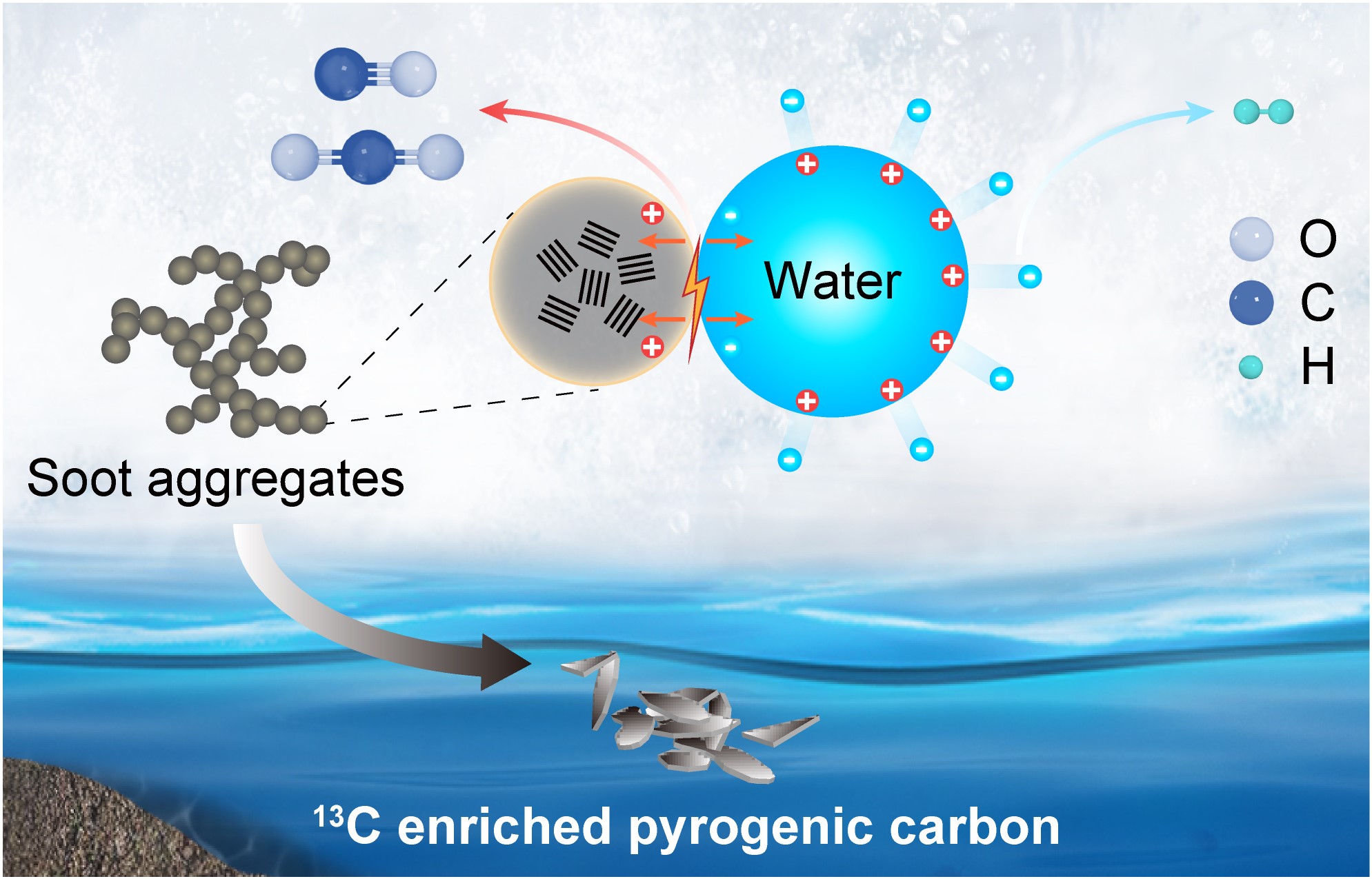
Ruolan Zhang,¹ Zhenyuan Zhang,¹ Xuke Chen,¹ Jichun Jiang, Lei Hua, Xiuquan Jia,* Rui Bao,* and Feng Wang*
J. Am. Chem. Soc., 2024, DOI: 10.1021/jacs.4c00290
Surface waves are known for their mechanical role in coastal processes affecting weather and climate. However, their chemical impact, especially on pyrogenic carbon transformation, is poorly understood. Pyrogenic carbon is generally assumed to show negligible post-formation alteration of its stable carbon isotope composition. Here we present an electrochemical interaction of pyrogenic carbon with seawater microdroplets resulting from wave breaking, driven by galvanic coupling at the microdroplet water-carbon and the microdroplet water-vapor interfaces. This process allows refractory pyrogenic carbon to degrade rapidly through oxygenation and mineralization, enriching it in ¹³C (~2.6‰), which is beyond the assumed values (< 0.5‰). Seawater microdroplets' unique chemical dynamics provide new insights into carbon isotope discrepancies between riverine and marine black carbon, emphasizing coastal oceans' role in global carbon sequestration.

Yuting Liu, Beili Nie, Ning Li, Huifang Liu *, Feng Wang *
Chin. J. Catal., 2024, 58, 123-128.
The C(sp³)−H functionalization of naturally abundant alkanes is of great importance, whereas C−H bond oxidation of aryl ethers in a redox-neutral and environmental-friendly manner remains a challenge. Herein, we report a novel method of visible-light-driven C(sp³)−H bond oxidation of aryl ethers selectively into ester products using oxygen as the oxidant. During the photocatalytic reaction using Mes-10-phenyl-Acr⁺−BF₄⁻ catalyst, chlorine radicals are generated from a wide variety of chloride sources and can effectively activate aryl ether C(sp³)−H bonds into alkyl radicals through the hydrogen atom transfer (HAT) process. Aryl ethers with different substituents can be oxidized to esters in good to excellent yields. This work presents a new photocatalytic strategy for C(sp³)−H oxidation of aryl ethers in a convenient and green manner.
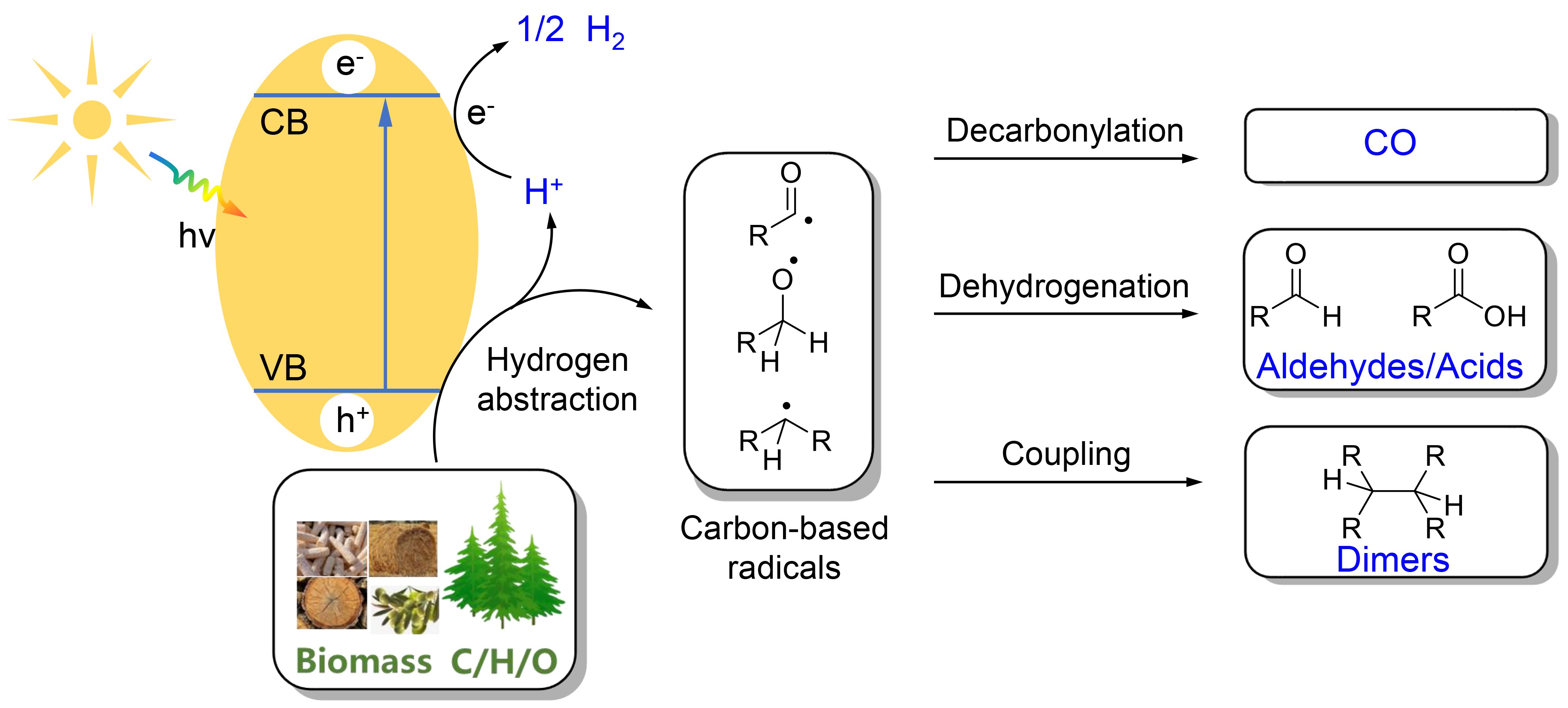
Min Wang, Hongru Zhou, Feng Wang
Recently, the team of Bioenergy Chemical Group (DNL0603) led by Prof. Wang Feng from the Dalian Institute of Chemical Physics (DICP) of the Chinese Academy of Sciences cooperated with the team of Prof. Wang Min from Dalian University of Technology was recently invited to prospect the topic about photocatalytic biomass conversion to hydrogen and carbon-based chemcials. The article was published in the Joule. This work was supported by the National Natural Science Foundation of China.